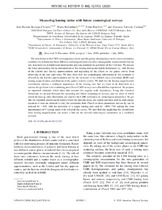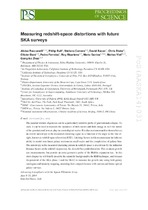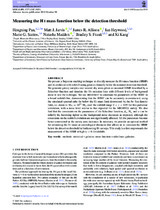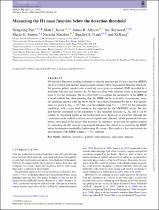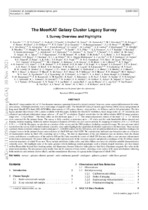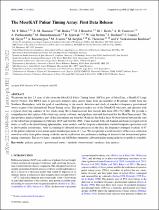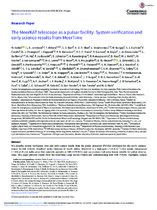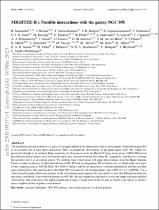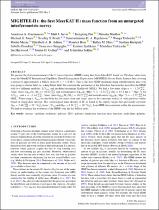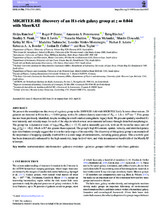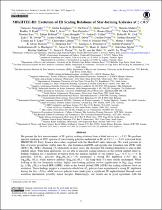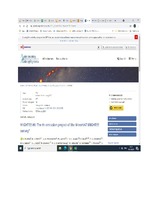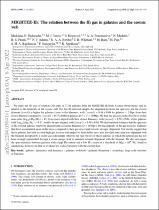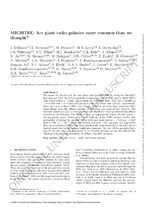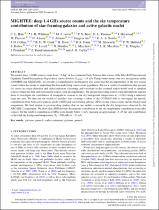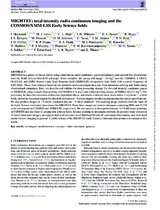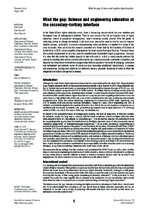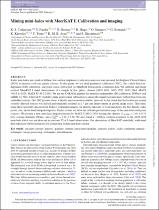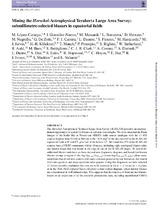Browsing Physics and Astronomy by Title
Now showing items 290-309 of 520
-
Measuring lensing ratios with future cosmological surveys
(American Physical Society, 2020)The ratio between the CMB lensing/galaxy counts and the galaxy shear/galaxy counts cross-correlations combines the information from different cosmological probes to infer cosmographic measurements that are less dependent ... -
Measuring redshift-space distortion with future SKA surveys
(Proceedings of Science, 2014)The peculiar motion of galaxies can be a particularly sensitive probe of gravitational collapse. As such, it can be used to measure the dynamics of dark matter and dark energy as well the nature of the gravitational laws ... -
Measuring the H I mass function below the detection threshold
(Oxford University Press, 2019-10-30)We present a Bayesian stacking technique to directly measure the H I mass function (HIMF) and its evolution with redshift using galaxies formally below the nominal detection threshold. We generate galaxy samples over ... -
Measuring the HI mass function below the detection threshold
(Royal Astronomical Society, 2020)We present a Bayesian stacking technique to directly measure the H I mass function (HIMF) and its evolution with redshift using galaxies formally below the nominal detection threshold. We generate galaxy samples over several ... -
The MeerKAT Galaxy Cluster Legacy Survey: Survey overview and highlights
(University of the Western Cape, 2022)MeerKAT’s large number (64) of 13.5 m diameter antennas, spanning 8 km with a densely packed 1 km core, create a powerful instrument for wide-area surveys, with high sensitivity over a wide range of angular scales. The ... -
The MeerKAT pulsar timing array: First data release
(Oxford University Press, 2022)We present the first 2.5 years of data from the MeerKAT Pulsar Timing Array (MPTA), part of MeerTime, a MeerKAT Large Survey Project. The MPTA aims to precisely measure pulse arrival times from an ensemble of 88 pulsars ... -
The MeerKAT telescope as a pulsar facility: System verification and early science results from MeerTime
(2020)We describe system verification tests and early science results from the pulsar processor (PTUSE) developed for the newly commissioned 64-dish SARAO MeerKAT radio telescope in South Africa. MeerKAT is a high-gain ( ) ... -
Mergers, starbursts, and quenching in the SIMBA simulation
(Oxford Academic, 2019)We use the SIMBAcosmological galaxy formation simulation to investigate the relationship between major mergers (4:1), starbursts, and galaxy quenching. Mergers are identified via sudden jumps in stellar mass M∗ well above ... -
Mightee-h i: Possible interactions with the galaxy NGC 895
(Oxford University Press, 2023)The transformation and evolution of a galaxy is strongly influenced by interactions with its environment. Neutral hydrogen (H i) is an excellent way to trace these interactions. Here, we present H i observations of the ... -
MIGHTEE-H I: the first MeerKAT H I mass function from an untargeted interferometric survey
(Oxford University Press, 2023)We present the first measurement of the H I mass function (HIMF) using data from MeerKAT, based on 276 direct detections from the MeerKAT International GigaHertz Tiered Extragalactic Exploration (MIGHTEE) Survey Early ... -
MIGHTEE-HI: discovery of an HI-rich galaxy group at z = 0.044 with MeerKAT
(Monthly Notices of the Royal Astronomical Society, 2021)We present the serendipitous discovery of a galaxy group in the XMM-LSS field with MIGHTEE Early Science observations. 20 galaxies are detected in HI in this z ∼ 0.044 group, with a 3σ column density sensitivity of NHI = ... -
Mightee-hi: Evolution of hi scaling relations of star-forming galaxies at z < 0.5*
(IOP Publishing, 2022)We present the first measurements of H I galaxy scaling relations from a blind survey at z > 0.15. We perform spectral stacking of 9023 spectra of star-forming galaxies undetected in H I at 0.23 < z < 0.49, extracted ... -
MIGHTEE-HI: The H » i emission project of the MeerKAT MIGHTEE survey
(EDP Sciences, 2021)We present the H » I emission project within the MIGHTEE survey, currently being carried out with the newly commissioned MeerKAT radio telescope. This is one of the first deep, blind, medium-wide interferometric surveys ... -
MIGHTEE-Hi: The relation between the Hi gas in galaxies and the cosmic web
(Oxford University Press, 2022)We study the 3D axis of rotation (3D spin) of 77 Hi galaxies from the MIGHTEE-Hi Early Science observations, and its relation to the filaments of the cosmic web. For this Hi-selected sample, the alignment between the spin ... -
MIGHTEE: Are giant radio galaxies more common than we thought?
(Oxford University Press, 2021)We report the discovery of two new giant radio galaxies (GRGs) using the MeerKAT International GHz Tiered Extragalactic Exploration (MIGHTEE) survey. Both GRGs were found within a ∼}1\, deg2 region inside the COSMOS field. ... -
Mightee: Deep 1.4 ghz source counts and the sky temperature contribution of star-forming galaxies and active galactic nuclei
(Oxford University Press, 2023)We present deep 1.4 GHz source counts from ∼5 deg2 of the continuum Early Science data release of the MeerKAT International Gigahertz Tiered Extragalactic Exploration survey down to S1.4GHz ∼15 μ Jy. Using observations ... -
MIGHTEE: Total intensity radio continuum imaging and the COSMOS/XMM-LSS Early Science fields
(University of the Western Cape, 2022)MIGHTEE is a galaxy evolution survey using simultaneous radio continuum, spectropolarimetry, and spectral line observations from the South African MeerKAT telescope. When complete, the survey will image ∼20 deg2 over the ... -
Mind the gap: Science and engineering education at the secondary–tertiary interface
(Academy of Science of South Africa, 2013)In the South African higher education sector, there is increasing concern about the poor retention and throughput rates of undergraduate students. There is also concern that the participation rates in higher education, ... -
Mining mini-halos with MeerKAT I. Calibration and imaging
(Oxford University Press, 2023)Radio mini-halos are clouds of diffuse, low-surface brightness synchrotron emission that surround the Brightest Cluster Galaxy (BCG) in massive cool-core galaxy clusters. In this paper, we use third generation calibration ... -
Mining the Herschel-Astrophysical Terahertz Large Area Survey: submillimetre-selected blazars in equatorial fields
(Oxford University Press, 2013)The Herschel-Astrophysical Terahertz Large Area Survey (H-ATLAS) provides an unprecedented opportunity to search for blazars at sub-mm wavelengths. We cross-matched the Faint Images of the Radio Sky at Twenty-cm (FIRST) ...

